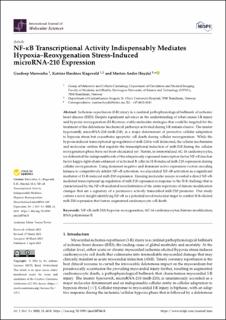| dc.contributor.author | Marwarha, Gurdeep Singh Atamjit | |
| dc.contributor.author | Slagsvold, Katrine Hordnes | |
| dc.contributor.author | Høydal, Morten Andre | |
| dc.date.accessioned | 2023-11-10T09:14:10Z | |
| dc.date.available | 2023-11-10T09:14:10Z | |
| dc.date.created | 2023-04-28T12:16:21Z | |
| dc.date.issued | 2023 | |
| dc.identifier.citation | International Journal of Molecular Sciences. 2023, 24(7), 6618. | en_US |
| dc.identifier.issn | 1661-6596 | |
| dc.identifier.uri | https://hdl.handle.net/11250/3101804 | |
| dc.description.abstract | Ischemia–reperfusion (I-R) injury is a cardinal pathophysiological hallmark of ischemic heart disease (IHD). Despite significant advances in the understanding of what causes I-R injury and hypoxia–reoxygenation (H-R) stress, viable molecular strategies that could be targeted for the treatment of the deleterious biochemical pathways activated during I-R remain elusive. The master hypoxamiR, microRNA-210 (miR-210), is a major determinant of protective cellular adaptation to hypoxia stress but exacerbates apoptotic cell death during cellular reoxygenation. While the hypoxia-induced transcriptional up-regulation of miR-210 is well delineated, the cellular mechanisms and molecular entities that regulate the transcriptional induction of miR-210 during the cellular reoxygenation phase have not been elucidated yet. Herein, in immortalized AC-16 cardiomyocytes, we delineated the indispensable role of the ubiquitously expressed transcription factor, NF-κB (nuclear factor kappa-light-chain-enhancer of activated B cells) in H-R-induced miR-210 expression during cellular reoxygenation. Using dominant negative and dominant active expression vectors encoding kinases to competitively inhibit NF-κB activation, we elucidated NF-κB activation as a significant mediator of H-R-induced miR-210 expression. Ensuing molecular assays revealed a direct NF-κB-mediated transcriptional up-regulation of miR-210 expression in response to the H-R challenge that is characterized by the NF-κB-mediated reorchestration of the entire repertoire of histone modification changes that are a signatory of a permissive actively transcribed miR-210 promoter. Our study confers a novel insight identifying NF-κB as a potential novel molecular target to combat H-R-elicited miR-210 expression that fosters augmented cardiomyocyte cell death. | en_US |
| dc.language.iso | eng | en_US |
| dc.publisher | MDPI | en_US |
| dc.rights | Navngivelse 4.0 Internasjonal | * |
| dc.rights.uri | http://creativecommons.org/licenses/by/4.0/deed.no | * |
| dc.title | NF-κB Transcriptional Activity Indispensably Mediates Hypoxia–Reoxygenation Stress-Induced microRNA-210 Expression | en_US |
| dc.title.alternative | NF-κB Transcriptional Activity Indispensably Mediates Hypoxia–Reoxygenation Stress-Induced microRNA-210 Expression | en_US |
| dc.type | Peer reviewed | en_US |
| dc.type | Journal article | en_US |
| dc.description.version | publishedVersion | en_US |
| dc.source.volume | 24 | en_US |
| dc.source.journal | International Journal of Molecular Sciences | en_US |
| dc.source.issue | 7 | en_US |
| dc.identifier.doi | 10.3390/ijms24076618 | |
| dc.identifier.cristin | 2144184 | |
| dc.source.articlenumber | 6618 | en_US |
| cristin.ispublished | true | |
| cristin.fulltext | original | |
| cristin.qualitycode | 1 | |

